Apps
Auto Added by WPeMatico
Auto Added by WPeMatico
Twitter has a history of sharing feature and design ideas it’s considering at very early stages of development. Earlier this month, for example, it showed off concepts around a potential “unmention” feature that would let users untag themselves from others’ tweets. Today, the company is sharing a few more of its design explorations that would allow users to better control who can see their tweets and who ends up in their replies. The new concepts include a way to tweet only to a group of trusted friends, new prompts that would ask people to reconsider the language they’re using when posting a reply, and a “personas” feature that would allow you to tweet based on your different contexts — like tweets about your work life, your hobbies and interests, and so on.
The company says it’s thinking through these concepts and is looking to now gather feedback to inform what it may later develop.
The first of the new ideas builds on work that began last year with the release of a feature that allows an original poster to choose who’s allowed to reply to their tweet. Today, users can choose to limit replies to only people mentioned in the tweet, only people they follow, or they can leave it defaulted to “everyone.” But even though this allows users to limit who can respond, everyone can see the tweet itself. And they can like, retweet or quote tweet the post.
With the proposed Trusted Friends feature, users could tweet to a group of their own choosing. This could be a way to use Twitter with real-life friends, or some other small network of people you know more personally. Perhaps you could post a tweet that only your New York friends could see when you wanted to let them know you were in town. Or maybe you could post only to those who share your love of a particular TV show, sporting event or hobby.
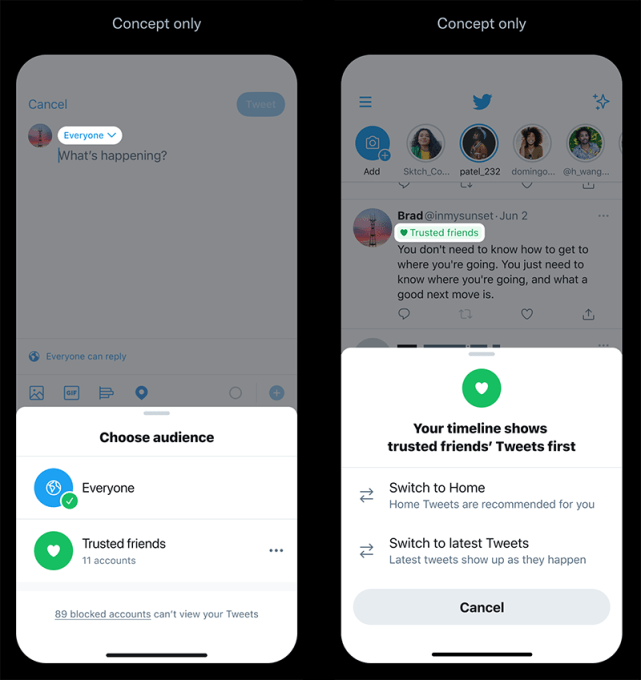
Image Credits: Twitter
This ability to have private conversations alongside public ones could boost people’s Twitter usage and even encourage some people to try tweeting for the first time. But it also could be disruptive to Twitter, as it would chip away at the company’s original idea of a platform that’s a sort of public message board where everyone is invited into the conversation. Users may begin to think about whether their post is worthy of being shared in public and decide to hold more of their content back from the wider Twitter audience, which could impact Twitter engagement metrics. It also pushes Twitter closer to Facebook territory where only some posts are meant for the world, while more are shared with just friends.
Twitter says the benefit of this private, “friends only” format is that it could save people from the workarounds they’re currently using — like juggling multiple alt accounts or toggling between public to protected tweets.
Another new feature under consideration is Reply Language Prompts. This feature would allow Twitter users to choose phrases they don’t want to see in their replies. When someone is writing back to the original poster, these words and phrases would be highlighted and a prompt would explain why the original poster doesn’t want to see that sort of language. For instance, users could configure prompts to appear if someone is using profanity in their reply.
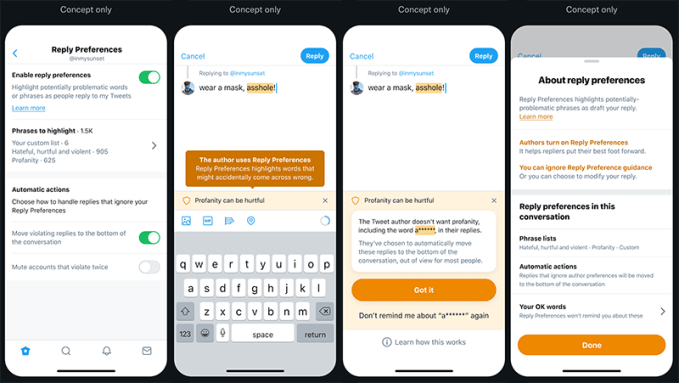
Image Credits: Twitter
The feature wouldn’t stop the poster from tweeting their reply — it’s more a gentle nudge that asks them to be more considerate.
These “nudges” can have impact. For example, when Twitter launched a nudge that suggested users read an article before they amplify it with a retweet, it found that users opened articles before sharing them 40% more often. But in the case of someone determined to troll, it may not do that much good.
The third, and perhaps most complicated, feature is something Twitter is calling “Facets.”
This is an early idea about tweeting from different personas from one account. The feature would make sense for those who often tweet about different aspects of their lives, including their work life, their side hustles, their personal life or family, their passions and more.
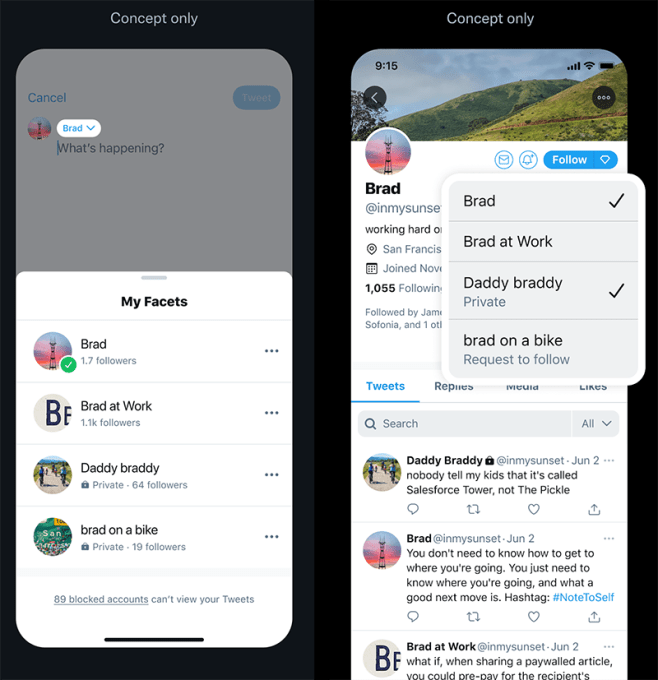
Image Credits: Twitter
Unlike Trusted Friends, which would let you restrict some tweets to a more personal network, Facets would give other users the ability to choose whether they wanted to follow all your tweets, or only those about the “facet” they’re interested in. This way, you could follow someone’s tweets about tech, but ignore their stream of reactions they post when watching their favorite team play. Or you could follow your friend’s personal tweets, but ignore their work-related content. And so on.
This is an interesting idea, as Twitter users have always worried about alienating some of their followers by posting “off-topic” so to speak. But this also puts the problem of determining what tweets to show which users on the end user themselves. Users may be better served by the algorithmic timeline that understands which content they engage with, and which they tend to ignore. (Also: “facets‽”)
Twitter says none of the three features are in the process of being built just yet. These are only design mockups that showcase ideas the company has been considering. It also hasn’t yet made the decision whether any of the three will go under development — that’s what the user feedback it’s hoping to receive will help to determine.
Powered by WPeMatico
This is your opportunity to get a glimpse of the future of iOS, iPadOS and watchOS. Apple just released the first public beta of iOS 15, iPadOS 15 and watchOS 8. Those releases are the next major versions of the operating systems for the iPhone, iPad and Apple Watch. Unlike developer betas, everyone can download these betas — you don’t need a $99 developer account. But don’t forget, it’s a beta.
The company still plans to release the final version of iOS 15, iPadOS 15 and watchOS 8 this fall. But Apple is going to release betas every few weeks over the summer. It’s a good way to fix as many bugs as possible and gather data from a large group of users.
As always, Apple’s public betas closely follow the release cycle of developer betas. Apple also released the second developer beta of iOS and iPadOS 15 today. So it sounds like the first public beta is more or less the same build as the second developer build.
But remember, you shouldn’t install a beta on your primary iPhone or iPad. The issue is not just bugs — some apps and features won’t work at all. In some rare cases, beta software can also brick your device and make it unusable. You may even lose data on iCloud. Proceed with extreme caution.
But if you have an iPad, iPhone or Apple Watch you don’t need, here’s how to download it. Head over to Apple’s beta website from the device you want to use for the beta and download the configuration profile — do that from your iPhone for the watchOS beta. It’s a tiny file that tells your device to update to public betas like it’s a normal software update.
Once it’s installed, reboot your device, then head over to the Settings (or Watch) app. You should see an update. In September, your device should automatically update to the final version of iOS 15, iPadOS 15 or watchOS 8 and you’ll be able to delete the configuration profile.
The biggest change of iOS 15 is a new Focus mode. In addition to “Do not disturb,” you can configure various modes — you can choose apps and people you want notifications from and change your focus depending on what you’re doing. For instance, you can create a Work mode, a Sleep mode, a Workout mode, etc.
There are many new features across the board, such as a new Weather app, updated maps in Apple Maps, an improved version of FaceTime with SharePlay and more. Safari also has a brand-new look.
Powered by WPeMatico
Common Sense Media has made a name for itself among parents as a useful resource for vetting entertainment and technology in terms of its age-appropriateness. Now, the organization’s for-profit affiliate, Common Sense Networks, is taking inspiration from those kid-friendly recommendations with the launch of a new streaming service called Sensical. The service offers age-appropriate, entertaining, and educational videos for children ages 2 through 10.
At launch, the free, ad-supported service includes over 15,000 hand-curated videos and over 50 topic-based channels for children to explore. And unlike other platforms, like Netflix or YouTube, Sensical doesn’t use algorithms to make content recommendations. Instead, kids are encouraged to follow their own interests and passions across over 50 topic-based channels. This includes things like Adventures, Animals, Arts & Crafts, Music, Science, Sports, Video Games, and other sorts of kid-friendly topics.
Kids can star these channels, or individual videos or series, in order to keep up with their favorite content in a dedicated Favorites section within the app.
They will see a selection of these channels based on their age, but the company is working to expand the channel lineup so there will be even more specific categories in the future. For example, instead of just “sports,” there could be channels like “soccer” or “gymnastics.” Instead of “Arts,” there could be “drawing” or “origami.” Instead of just “science,” it could include channels like “geography” or “robotics,” and so on.
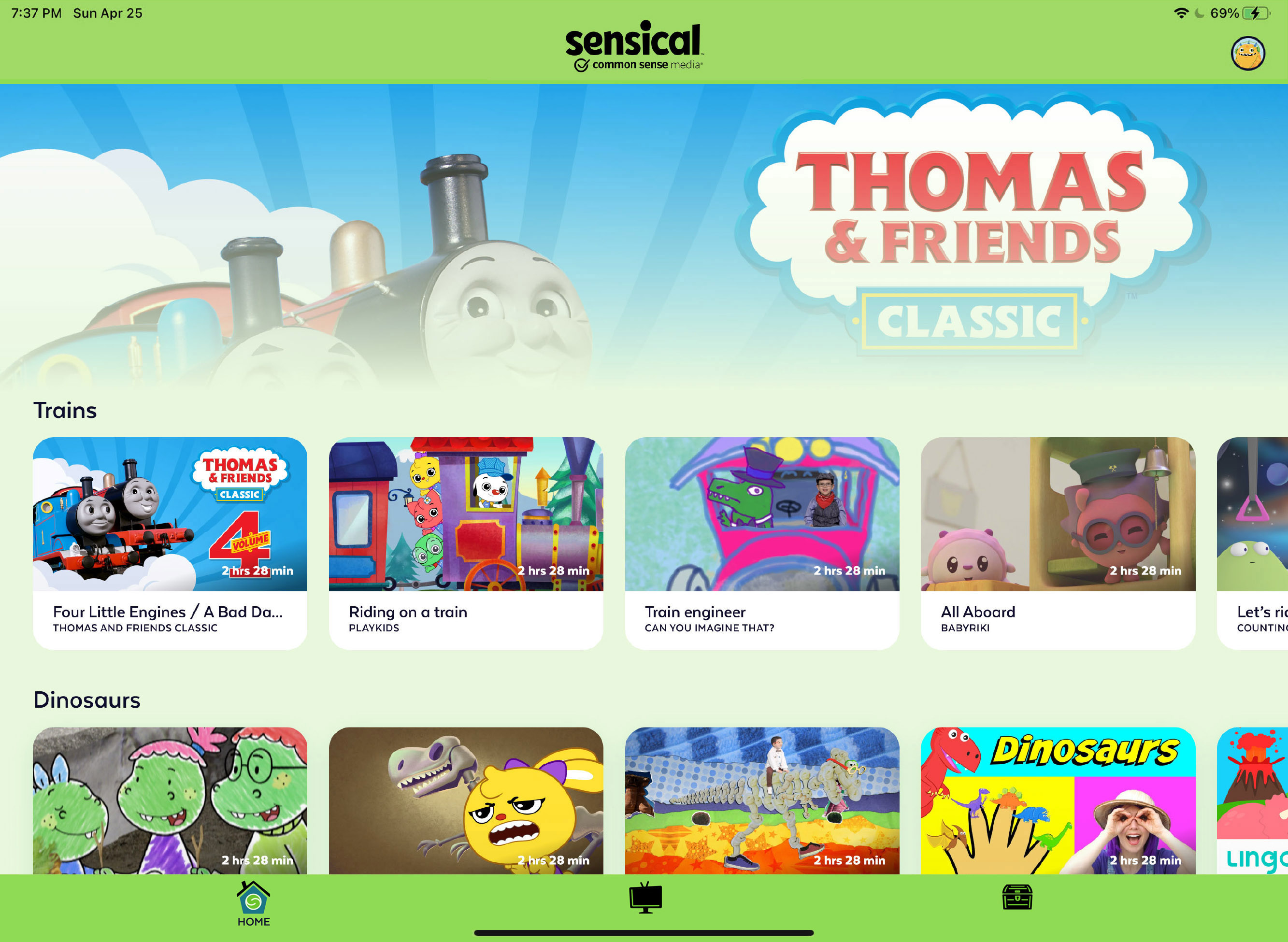
Image Credits: Common Sense Networks
The app also features a Live TV section, which is programmed throughout the day with kid-friendly content, so kids don’t have to browse to find something to quickly watch.
While other streaming services on the market offer kid-friendly content — as that’s a huge selling point for subscribers — it’s not always organized in a way that makes sense. Sometimes, all the content gets lumped into a general “Kids” category where videos for little kids are mixed in with content for older children. Sensical, meanwhile, curates the content recommendations into three different experiences, including preschool (2-4), little kids (5-7), and big kids (8-10).
What the child sees is based on how parents configure their profiles. Plus, parents can use the service’s ParentZone in-app dashboard to set screen-time limits, extend limits as needed, and view daily reports on what the child has watched.
The service’s best feature, however, is that the content is assured to be age-appropriate — even the ads.
This is possible because the curation approach Sensical takes is very different from YouTube Kids. YouTube’s app for kids leans on algorithms to filter out adult content from YouTube’s broader library, but the company doesn’t manually review all the videos it includes. It warns parents that some inappropriate content could slip through. (And it has.)
Common Sense Networks, meanwhile, says dozens of trained child-development experts view, vet and rate “every single frame of video” that goes live on its service using its proprietary IP and patent-pending process. This system involves tagging content with specific child-developmental benefits, too.
Sensical also vets its advertising, which is how the service is supported, with similar direct oversight. Its experts review the sponsor’s content to ensure it’s appropriate for children — an area that’s often overlooked on other services.
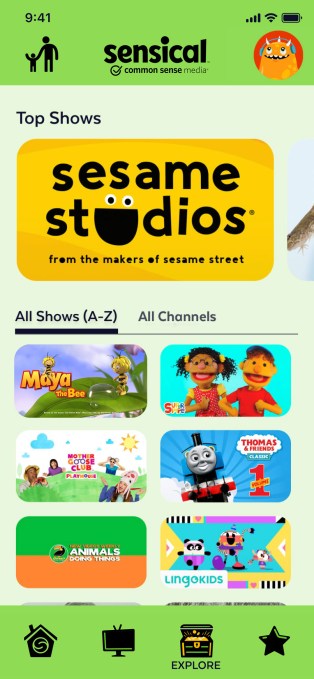
Image Credits: Common Sense Networks
To fill its library, Common Sense Networks partnered with dozens of studios and distribution partners, as well as digital-first creators.
Studio and distribution partners include CAKE (Poppy Cat), Cyber Group Studios (Leo The Wildlife Ranger), The Jim Henson Company (The Wubbulous World of Dr. Seuss, Jim Henson’s Animal Show with Stinky and Jake), Mattel (Kipper, Pingu, Max Steel), Raydar Media (Five Apples’ limited series, Apple Tree House), Superights (Bo Bear, Handico), WildBrain (Teletubbies, Rev & Roll), Xilam Animation (Learn and Play with Paprika, Moka’s Fabulous Adventures), ZDF Enterprises (Lexi & Lottie, School of Roars), Zodiak Kids (Mister Maker, Tee and Mo), ABC Commercial, CBC & Radio-Canada Distribution, Jetpack Distribution, Nelvana, 9 Story Distribution International, Sesame Workshop, Serious Lunch, and Studio 100.
Digital creators, meanwhile, include ABCMouse, Aaron’s Animals, Alphabet Rockers, batteryPOP, California Academy of Sciences, GoldieBlox, The Gotham Group’s Gotham Reads, Guggenheim Museum, Howdytoons, Kids’ Black History, MEL Science + Chemistry, N*Gen, Pinkfong, Penguin Random House’s Brightly Storytime, Studio71 (Parry Gripp, Maymo, Hyper Roblox), Tankee, Ubongo Kids, Vooks, Bounce Patrol, Hevesh5, Mother Goose Club, StacyPlays, Super Simple Songs and The Whistle.
The service abides by the U.S. children’s privacy laws (COPPA), and is certified by the kidSAFE Seal Program.
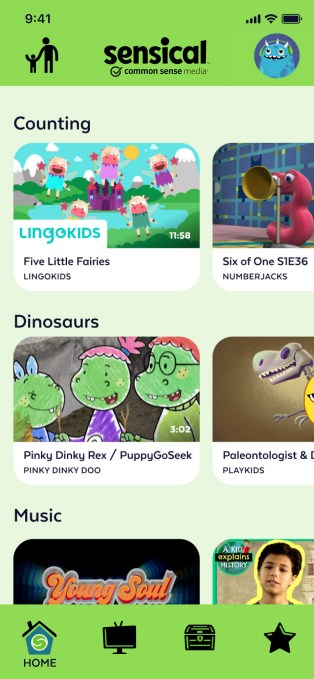
Image Credits: Common Sense Networks
Having briefly toyed around with the mobile app, it appears Sensical works as described. If I had any complaints personally, it would only be that the experience could be dismissed as “baby stuff” by older kids approaching their tween years, due to the cute pictures and youthful iconography used in the app’s design. Kids in older age groups take issue with being treated as if they’re younger — and they take particular notice of anything that does so.
The same complaint goes for the Live TV programming, which was clearly aimed at littler kids when we checked it out, despite testing the app as a child profile whose age was set to “10.”
I also think it would be nice if there were a better way to track Favorite channels and see when they’re updated with new videos, as kids moving to Sensical from YouTube will want to “feel” like they’re still connected to new and fresh content and not a library. But Sensical isn’t YouTube. There’s a trade-off between hand-curation and timeliness, and Sensical is favoring the former.
Sensical had been first introduced this spring during a closed beta, but is now publicly available to stream across web and mobile on iOS, Android, Roku, Amazon Fire TV and Apple TV. This summer, it will expand to more distribution platforms, including VIZIO.
Powered by WPeMatico
Instagram is building its own version of Twitter’s Super Follow with a feature that would allow online creators to publish “exclusive” content to their Instagram Stories that’s only available to their fans — access that would likely come with a subscription payment of some kind.
Instagram confirmed that the screenshots of the feature recently circulated across social media are from an internal prototype that’s now in development, but not yet being publicly tested. The company declined to share any specific details about its plans, saying they’re not at a place to talk about this project just yet.
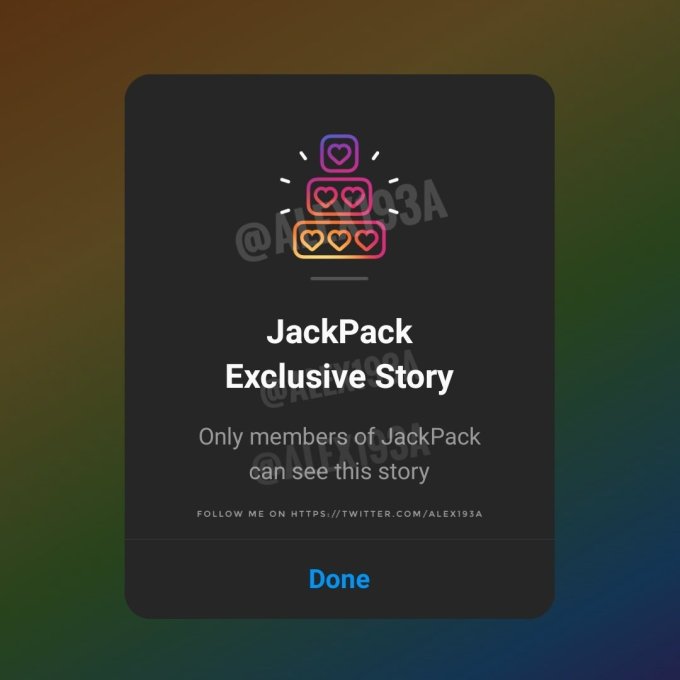
Image Credits: Exclusive Story in development via Alessandro Paluzzi
The screenshots, however, convey a lot about Instagram’s thinking, as they show a way that creators could publish what are being called “Exclusive Stories” to their accounts, which are designated with a different color (currently purple). When other Instagram users come across the Exclusive Stories, they’ll be shown a message that says that “only members” can view this content. The Stories cannot be screenshot, either, it appears, and they can be shared as Highlights. A new prompt encourages creators to “save this to a Highlight for your Fans,” explaining that, by doing so, “fans always have something to see when they join.”
The Exclusive Stories feature was uncovered by reverse engineer Alessandro Paluzzi, who often finds unreleased features in the code of mobile apps. Over the past week, he’s published a series screenshots to an ongoing Twitter thread about his findings.
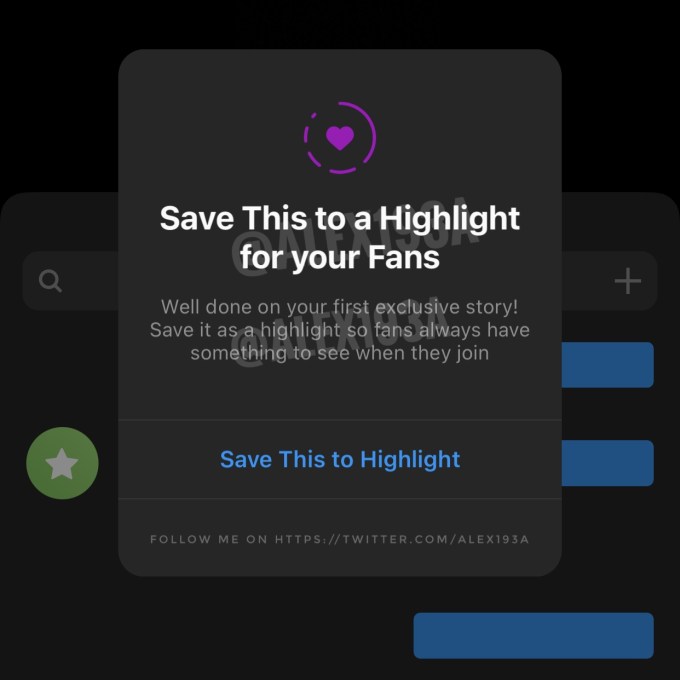
Image Credits: Instagram Exclusive Story Highlight feature in development via Alessandro Paluzzi (opens in a new window)
Exclusive Stories are only one part of Instagram’s broader plans for expanded creator monetization tools.
The company has been slowly revealing more details about its efforts in this space, with Instagram Head Adam Mosseri first telling The Information in May that the company was “exploring” subscriptions along with other new features, like NFTs.
Paluzzi also recently found references to the NFT feature, Collectibles, which shows how digital collectibles could appear on a creator’s Instagram profile in a new tab.

Image Credits: Instagram NFT feature in development via Alessandro Paluzzi (opens in a new window)
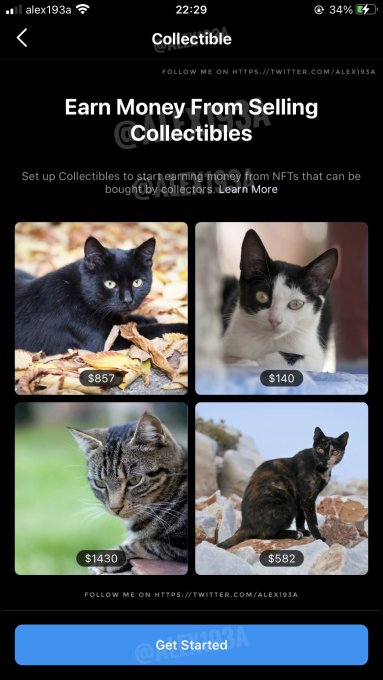
Image Credits: Alessandro Paluzzi (opens in a new window)
Instagram, so far, hasn’t made a public announcement about these specific product developments, instead choosing to speak at a high level about its plans around things like subscriptions and tips.
For example, during Instagram’s Creator Week in early June — an event that could have served as an ideal place to offer a first glimpse at some of these ideas — Mosseri talked more generally about the sort of creator tools Instagram was interested in building, without saying which were actually in active development.
“We need to create if we want to be the best platform for creators long term, a whole suite of things, or tools, that creators can use to help do what they do,” he said, explaining that Instagram was also working on more creative tools and safety features, as well as tools that could help creators make a living.
“I think it’s super important that we create a whole suite of different tools, because what you might use and what would be relevant for you as a creator might be very different than an athlete or a writer,” he said.
“And so, largely, [the creator monetization tools] fall into three categories. One is commerce — so either we can do more to help with branded content; we can do more with affiliate marketing…we can do more with merch,” he explained. “The second is ways for users to actually pay creators directly — so whether it is gated content or subscriptions or tips, like badges, or other user payment-type products. I think there’s a lot to do there. I love those because those give creators a direct relationship with their fans — which I think is probably more sustainable and more predictable over the long run,” Mosseri said.
The third area is focused on revenue share, as with IGTV long-form video and short-form video, like Reels, he added.
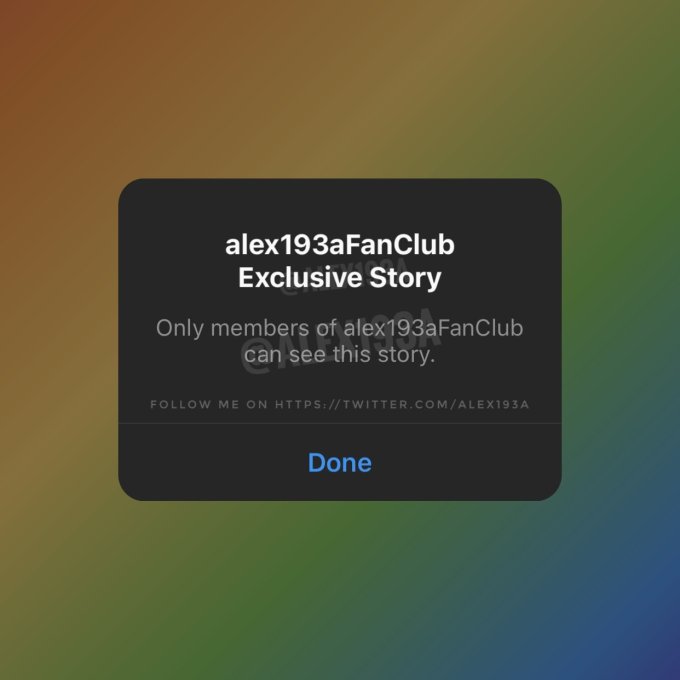
Image Credits: Instagram Exclusive Story feature in development via Alessandro Paluzzi (opens in a new window)
Instagram isn’t the only large social platform moving forward with creator monetization efforts.
The membership model, popularized by platforms like OnlyFans and Patreon, has been more recently making its way to a number of mainstream social networks as the creator economy has become better established.
Twitter, for example, first announced its own take on creator subscriptions, with the unveiling of its plans for the Super Follow feature during an Analyst Day event in February. Last week, it began rolling out applications for Super Follows and Ticketed Spaces — the latter, a competitor to Clubhouse’s audio social networking rooms.
Meanwhile, Facebook just yesterday launched its Substack newsletter competitor, Bulletin, which offers a way for creators to sell premium subscriptions and access member-only groups and live audio rooms. Even Spotify has launched an audio chat room and Clubhouse rival, Greenroom, which it also plans to eventually monetize.
Though the new screenshots offer a deeper look into Instagram’s product plans on this front, we should caution that an in-development feature is not necessarily representative of what a feature will look like at launch or how it will ultimately behave. It’s also not a definitive promise of a public launch — though, in this case, it would be hard to see Instagram scrapping its plans for exclusive, member-only content given its broader interest in serving creators, where such a feature is essentially part of a baseline offering.
Powered by WPeMatico
Last fall, Facebook announced it was opening an office in Lagos, Nigeria, which would provide the company with a hub in the region and the first office on the continent staffed with a team of engineers. We’ve now spotted one of the first products to emerge from this office: an education-focused mobile app called Sabee, which means “to know” in Nigerian Pidgin. The app aims to connect learners and educators in online communities to make educational opportunities more accessible.
The app was briefly published to Google Play by “NPE Team,” the internal R&D group at Facebook, which has typically focused on new social experiences in areas like dating, audio, music, video, messaging and more.
While the learnings from the NPE Team’s apps sometimes inform broader Facebook efforts, the group hasn’t yet produced an app that has graduated to become a standalone Facebook product. Many of its earlier apps have also shut down, including (somewhat sadly), the online zine creator Eg.g, video app Hobbi, calling app CatchUp, friend-finder Bump, podcast community app Venue, and several others.
Sabee, however, represents a new direction for the NPE Team, as it’s not about building yet another social experiment.
Instead, Sabee is tied to Facebook’s larger strategy of focusing more on serving the African continent, starting with Nigeria. This is a strategic move, informed by data that indicates a larger majority of the world’s population will be in urban centers by 2030, and much of that will be on the African continent and throughout the Middle East. By 2100, Africa’s population is expected to have tripled, with Nigeria becoming the second-most populated country in the world, behind China.
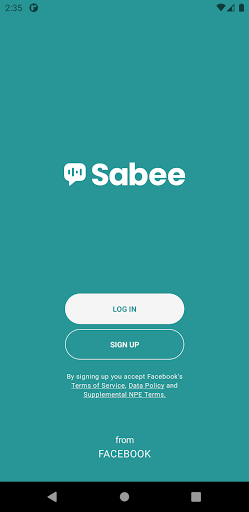
Image Credits: Facebook NPE Team
To address the need to connect these regions to the internet, Facebook teamed with telcos on 2Africa, a subsea cable project that aims to serve the over 1 billion people still offline in Africa and the Middle East. These aren’t altruistic investments, of course — Facebook knows its future growth will come from these demographics.
Facebook confirmed its plans for Sabee to TechCrunch after we discovered it, noting it was still a small test for the time being.
“There are 50 million learners, but only 2 million educators in Nigeria,” said Facebook Product Lead, Emeka Okafor. “With this small, early test, we’re hoping to understand how we can help educators build communities that make education available to everyone. We look forward to learning with our early testers, and deciding what to do from there.”
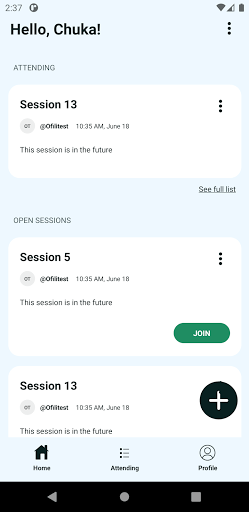
Image Credits: Facebook NPE Team
The disparity between learners and educators in Nigeria greatly impacts women and girls, which is another key focus for Sabee — and the NPE Team’s efforts in the region as a whole. The company also wants to explore how to better serve groups who are often left behind by technology. On this front, Sabee is working to create an experience that works with low connectivity, like 2G.
We understand the app is currently in early alpha testing with fewer than 100 testers who are under NDA agreements with Facebook. It’s not available for anyone else beyond that group at present, but the company hopes to scale Sabee to the next stage before the end of the year.
There is no way to sign up for a Sabee waitlist, and the app is no longer public on Google Play. It was available so briefly that it was never ranked on any charts, app store intelligence firm Sensor Tower confirmed to us.
We should note that “sabee” and “sabi/sabis” have other, less-polite meanings in different languages, per Urban Dictionary. But the team has no plans to change the name for now as it makes sense in the Nigerian market where the app is targeted.
Powered by WPeMatico
Samsung’s Mobile World Congress presser was, once again, all about wearables. The big news at this evening’s (or afternoon’s, timezone dependent) event was our best look yet at a redesigned interface for the company’s line of Galaxy Watches.
One UI Watch – which takes its name from the Galaxy mobile interface — will share a design language with the one found on the company’s line of Galaxy phones. The upcoming One UI Watch will debut at an upcoming Unpacked event later this summer, sporting the new UI, as well as the forthcoming joint Samsung/Google platform.
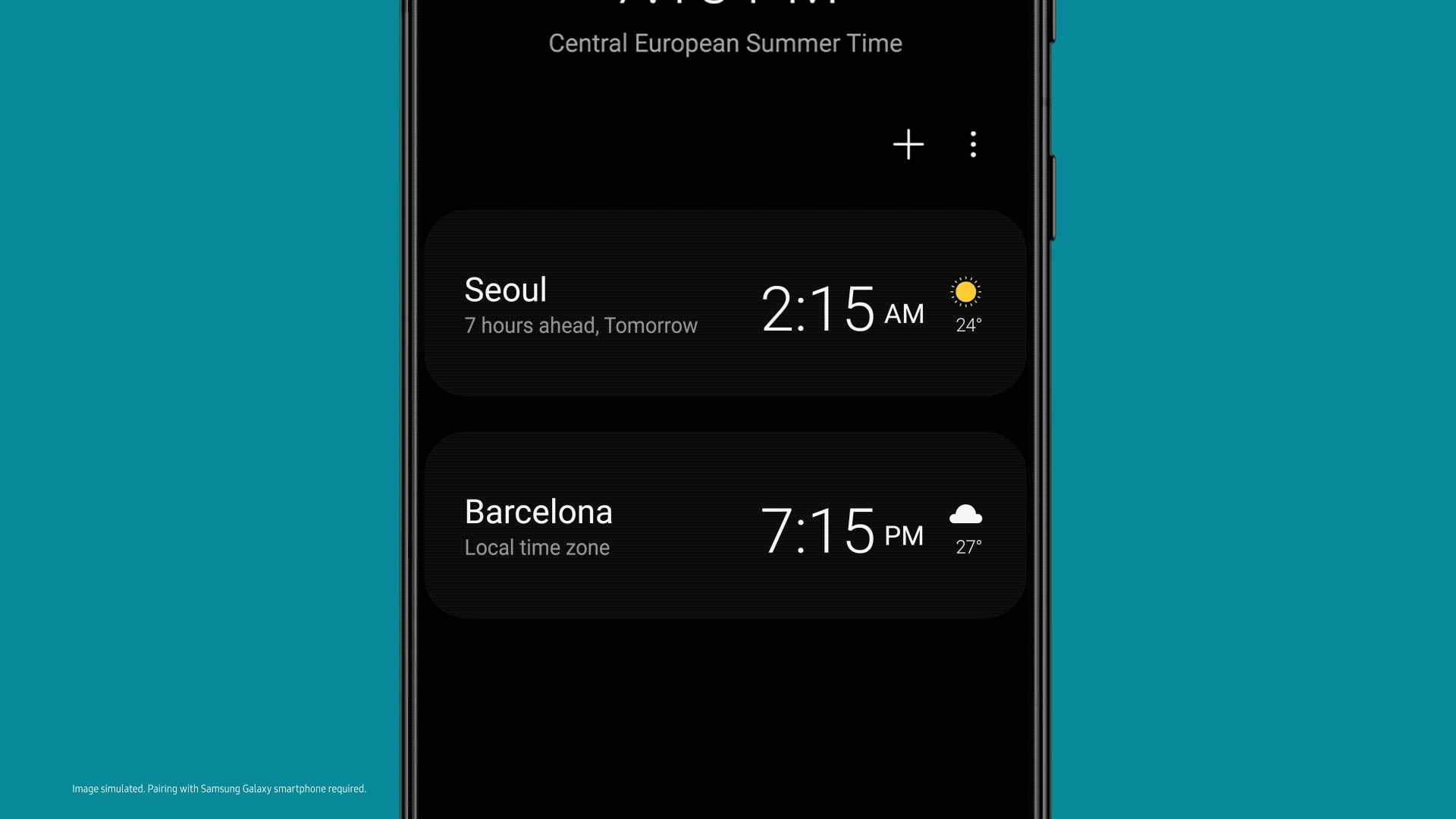
Image Credits: Samsung/Google
It was first teased at I/O last month that the two technology powerhouses would be teaming up on a wearables project. We still have little in the way of information about it, however, – including what it will actually be called.
The partnership was initially announced as a “unified platform” that would allow developers to create a single app for both Google’s Wear OS and Tizen, the open-source operating system Samsung has long relied on for its own smartwatches. As we noted at the time, third-party app development has proven a considerable hurdle for both companies as they look to take on Apple’s dominance of the space.
Among the benefits of the partnerships is that once a watch-compatible app has been downloaded on a connected smartphone, it will also be downloaded to the watch. Along with first-party Google apps like Maps and YouTube Music, the list includes Spotify (naturally), Calm, Strava, Adidas Running and Sleep Cycle.
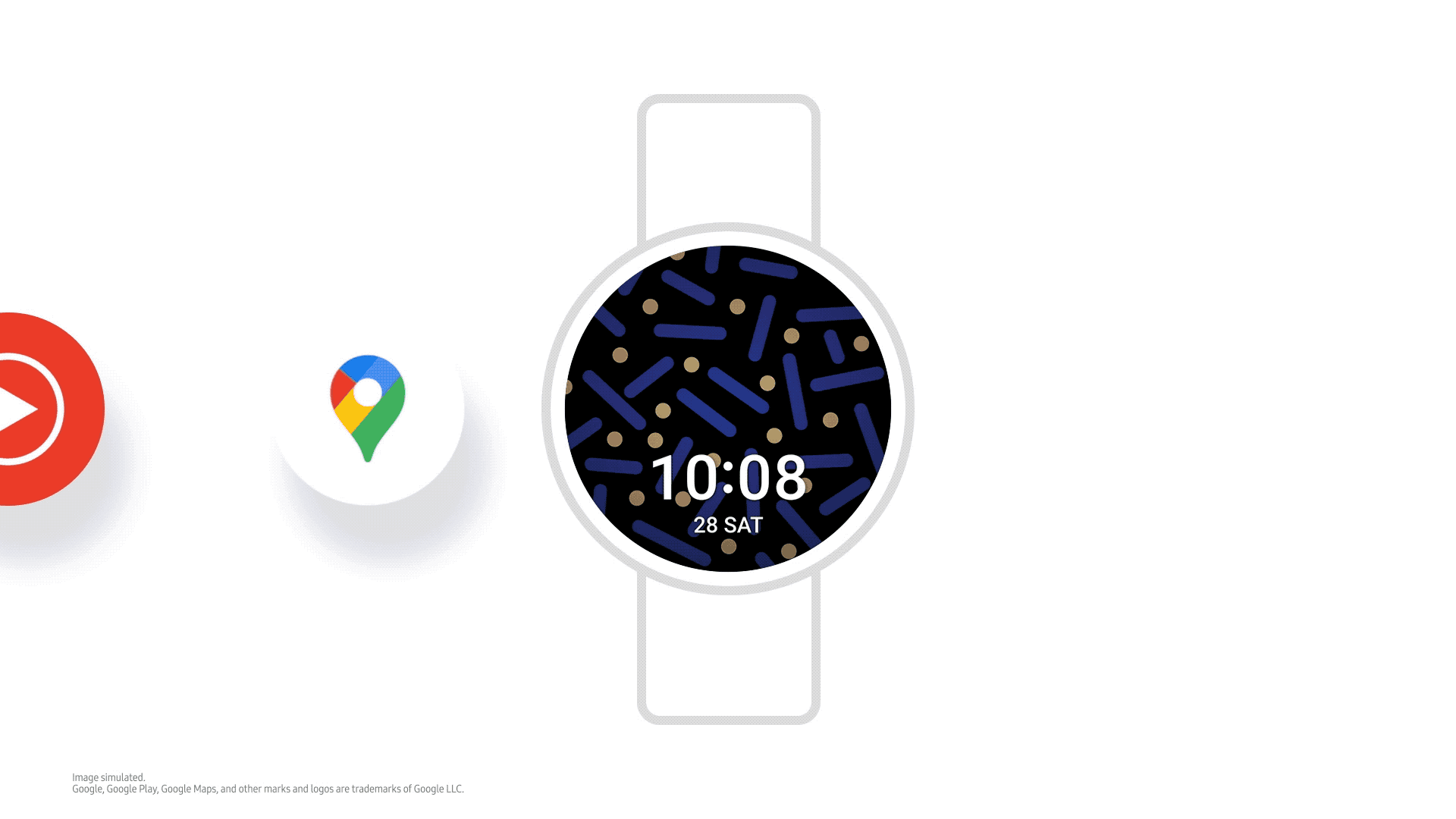
Image Credits: Samsung/Google
“Samsung and Google have a long history of collaboration, and whenever we’ve worked together, the experience for our consumers has been dramatically better for everyone,” Google SVP Sameer Samat said in a release tied to the news. “That certainly holds true for this new, unified platform, which will be rolling out for the first time on Samsung’s new Galaxy Watch. In collaboration with Samsung, we’re thrilled to bring longer battery life, faster performance, and a wide range of apps, including many from Google to a whole new wearable experience.”
Such a partnership seems odd at first blush – Samsung long ago eschewed Google’s wearable operating system in favor of its own heavily customized version of Tizen. Ultimately, however, it seems the two are united against the monolith that is Apple – which currently enjoys somewhere in the neighborhood of 40% of the global market. Samsung is in second, but even with Fitbit under its wing, Google’s still got a ways to go.
Samsung will also be showing off improved development tools that make it easier to create things like watch faces for the platform.
Powered by WPeMatico
Shopify changed the e-commerce landscape by making it easier for merchants to set up their websites both quickly and affordably. A startup called Tapcart is now doing the same for mobile commerce.
The company, which has referred to itself as the “Shopify for mobile apps,” today powers the shopping apps for top brands, including Fashion Nova, Pier One Imports, The Hundreds, Patta, Culture Kings, and thousands more. Following a year of 3x revenue growth, in part driven by the pandemic, Tapcart is today announcing the close of a $50 million round of Series B funding, led by Left Lane Capital. Having clearly taken notice of Tapcart’s traction with its own merchant base, Shopify is among the round’s participants.
Other investors in the round include SignalFire, Greycroft, Act One Ventures and Amplify LA.
Tapcart’s co-founders, Sina Mobasser and Eric Netsch, have worked in the mobile app industry for years. Mobasser’s previous company, TestMax, offered one of the first test prep courses on iOS, while Netsch had more recently worked on the agency side to create mobile and digital experiences for brands. Together, the two realized the potential in helping online merchants bring their businesses to mobile, as easily as they were able to go online with Shopify.
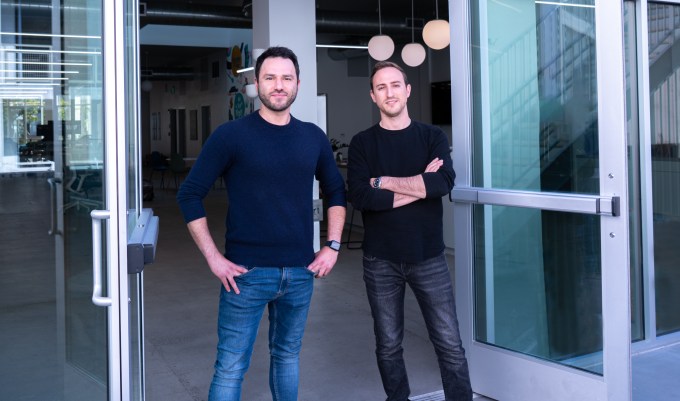
Tapcart’s founders Sina Mobasser and Eric Netsch at their Santa Monica HQ. Image Credits: Tapcart
“Now, you can launch an app on our platform in a matter of weeks, where historically it would take up to a year if you wanted to custom build an app,” explains Mobasser. “And you can do it for a low monthly fee.”
Tapcart’s platform itself offers a simple drag-and-drop builder that allows anyone to create a mobile app for their existing Shopify store using tools to design their layout, customize the product detail pages, integrate checkout options, include product reviews, and even optionally add other branded content, like blogs, lookbooks, videos (including live video) and more. Everything is synced directly from Shopify to the app in real-time, so the merchant’s inventory, products and collections are all kept up-to-date. That’s a big differentiator from some rivals, which require duplicate sets of data and data transformation.
Tapcart, meanwhile, leverages all of Shopify’s APIs and SDKs to create a native application that works with Shopify’s existing data structures.
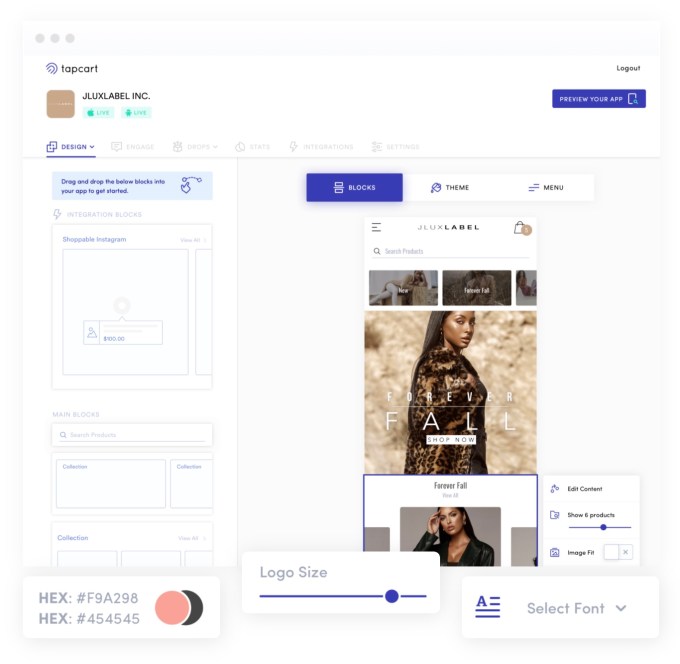
Image Credits: Tapcart
This tight integration with Shopify helps Tapcart because it doesn’t have to focus on the e-commerce infrastructure, as the way things are structured around inventory and collections are roughly 90% the same across brands. Instead, Tapcart focuses on the 10% that makes brands stand out from one another, which includes things like branding, content and design. Its CMS allows merchants to create exclusive content, change the colors and fonts, add videos and more to make the app look and feel fully customized.
Beyond the mobile app creation aspect to its business, Tapcart also helps merchants automate their marketing. Through the Tapcart platform, merchants can communicate with their customers in real-time using push notifications that can alert them to new sales, to encourage them to return to abandoned carts, or any other promotions. The marketing campaigns can be automated, as well, which helps merchants schedule their upcoming launches and product drops ahead of time. The company claims these push notifications deliver click-through rates that are 72% higher than a traditional email or SMS text because of their interactivity and branding.
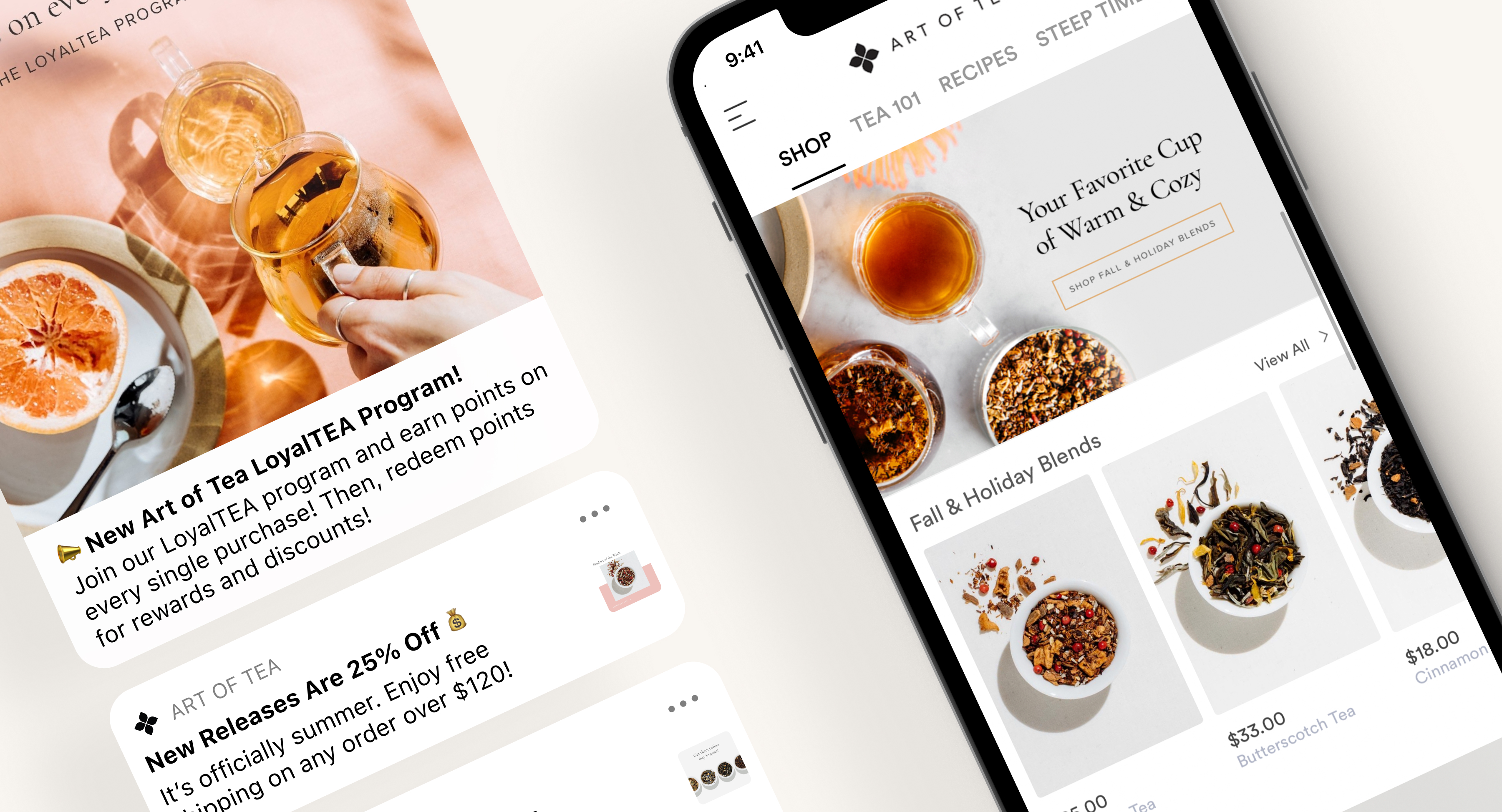
Image Credits: Tapcart
The platform has quickly found traction with SMB to mid-market enterprise customers who have reached the stage of their business where it makes sense for them to double down on customer retention and conversion and optimize their mobile workflow.
“Our sweet spot is when you have maybe a couple hundred customers in your database,” notes Netsch. “That’s a perfect time to now focus less on the paid acquisition portion of your business and more on how to retain and engage those existing customers, [so they’ll] shop more and have a better experience,” he says.
During the past 12 months, over $1.2 billion in merchant sales have flowed through Tapcart’s platform. And in 2020, Tapcart’s recurring revenue increased by 3x, as mobile apps grew even faster during the pandemic, which had increased consumer mobile screen time by 20% year-over-year from 2019. Mobile commerce spending also grew 55% year-over-year, topping $53 billion globally during the holiday shopping season, the company says. Tapcart’s own merchants saw mobile app orders at a rate of more than once-per-second during this time, and it believes these trends will continue even as the pandemic comes to an end.
Today, Tapcart generates revenue by charging a flat SaaS (software-as-a-service) fee, which differentiates it from a number of competitors who charge a percent of the merchant’s total sales.

Image Credits: Tapcart
With the additional funding, Tapcart plans to focus on its goal of becoming a vertically integrated mobile commerce suite of tools, which more recently includes support for iOS App Clips. It will also soon release an upgraded version of its insights analytics platform and will offer scripts that merchants can install on their mobile websites to compare what works on the site versus what works in the app.
Later this year, Tapcart plans to launch a full marketing automation product that will allow brands to automate and personalize their notifications even further. And it plans to invest in market expansions to make its product better designed for mobile, global commerce.
The funding will allow Santa Monica-based Tapcart to hire another 200 people over the next 24 months, up from the 70 it has currently. These will include new additions across time zones and even in markets like Australia and Europe as it moves toward global expansion.
Shopify’s investment will open up a number of new opportunities as well, including on product, engineering, business strategy and partnerships. It will also help to get Tapcart in front of Shopify’s 1.7 million global merchants.
“There’s still quite a lot of merchants that need better mobile experiences, but have yet to really double down on the mobile effort and get something like a native app,” notes Netsch. “There’s a lot of different ways and methods that merchants are experimenting with mobile growth, and we’re trying to offer all of the best parts of that in a single platform. So there’s tons of expansion for Tapcart to do just that with the existing target addressable market,” he says.
“We believe brands must be where their customers are, and today that means being on their phones,” said Satish Kanwar, VP of product acceleration at Shopify, in a statement. “Tapcart helps merchants create mobile-first shopping experiences that customers love, reinforcing Shopify’s mission to make commerce better for everyone. We look forward to seeing Tapcart expand its success on Shopify with the more than 1.7 million merchants on our platform today.”
Powered by WPeMatico
Time is your most valuable asset — as the saying goes — and today a startup called Memory.ai, which is building AI-based productivity tools to help you with your own time management, is announcing some funding to double down on its ambitions: It wants not only to help manage your time, but to, essentially, provide ways to use it better in the future.
The startup, based out of Oslo, Norway, initially made its name with an app called Timely, a tool for people to track time spent doing different tasks. Aimed not just at people who are quantified self geeks, but those who need to track time for practical reasons, such as consultants or others who work on the concept of billable hours. Timely has racked up 500,000 users since 2014, including more than 5,000 paying businesses in 160 countries.
Now, Memory.ai has raised $14 million as it gears up to launch its next apps, Dewo (pronounced “De-Voh”), an app that is meant to help people do more “deep work” by learning about what they are working on and filtering out distractions to focus better; and Glue, described as a knowledge hub to help in the creative process. Both are due to be released later in the year.
The funding is being led by local investors Melesio and Sanden, with participation from Investinor, Concentric and SNÖ Ventures, who backed Memory.ai previously.
“Productivity apps” has always been something of a nebulous category in the world of connected work. They can variously cover any kind of collaboration management software ranging from Asana and Jira through to Slack and Notion; or software that makes doing an existing work task more efficient than you did it before (e.g. Microsoft has described all of what goes into Microsoft 365 — Excel, Word, PowerPoint, etc. — as “productivity apps”); or, yes, apps like those from Memory.ai that aim to improve your concentration or time management.
These days, however, it feels like the worlds of AI and advances in mobile computing are increasingly coming together to evolve that concept once again.
If the first wave of smartphone communications and the apps that are run on smartphone devices — social, gaming, productivity, media, information, etc. — have led to us getting pinged by a huge amount of data from lots of different places, all of the time, then could it be that the second wave is quite possibly going to usher in a newer wave of tools to handle all that better, built on the premise that not everything is of equal importance? No-mo FOMO? We’ll see.
In any case, some bigger platform players also helping to push the agenda of what productivity means in this day and age.
For example, in Apple’s recent preview of iOS 15 (due to come out later this year) the company gave a supercharge to its existing “do not disturb” feature on its phones, where it showed off a new Focus mode, letting users customize how and when they want to receive notifications from which apps, and even which apps they want to have displayed, all organized by different times of day (e.g. work time), place, calendar items and so on.
“Today, iPhone plays so many roles in our lives. It’s where we get information, how people reach us, and where we get things done. This is great, but it means our attention is being pulled in so many different directions and finding that balance between work and life can be tricky,” said Apple’s Craig Federighi in the WWDC keynote earlier this month. “We want to free up space to focus and help you be in the moment.” How well that gets used, and how much other platforms like Google follow suit, will be interesting to see play out. It feels, in any case, like it could be the start of something.
And, serendipitously — or maybe because this is some kind of zeitgeist — this is also playing into what Memory.ai has built and is building.
Mathias Mikkelsen, the Oslo-based founder of Memory.ai, first came up with his idea for Timely (which had also been the original name of the whole startup) when he was working as a designer in the ad industry, one of those jobs that needed to track what he was working on, and for how long, in order to get paid.
He said he knew the whole system as it existed was inefficient: “I just thought it was insane how cumbersome and old it was. But at the same time how important it was for the task,” he said.
The guy had an entrepreneurial itch that he was keen to scratch, and this idea would become the salve to help him. Mikkelsen was so taken with building a startup around time management, that he sold his apartment in Oslo and moved himself to San Francisco to be where he believed was the epicenter of startup innovation. He tells me he lived off the proceeds of his flat for two years “in a closet” in a hacker house, bootstrapping Timely, until eventually getting into an accelerator (500 Startups) and subsequently starting to raise money. He eventually moved back to Oslo after two years to continue growing the business, as well as to live somewhere a little more spacious.
The startup’s big technical breakthrough with Timely was to figure out an efficient way of tracking time for different tasks, not just time worked on anything, without people having to go through a lot of data entry.
The solution: to integrate with a person’s computer, plus a basic to-do schedule for a day or week, and then match up which files are open when to determine how long one works for one client or another. Phone or messaging conversations, for the moment, are not included, and neither are the contents of documents — just the titles of them. Nor is data coming from wearable devices, although you could see how that, too, might prove useful.
The basic premise is to be personalised, so managers and others cannot use Timely to track exactly what people are doing, although they can track and bill for those billable hours. All this is important, as it also will feed into how Dewo and Glue will work.
The startup’s big conceptual breakthrough came around the same time: Getting time tracking or any productivity right “has never been a UI problem,” Mikkelsen said. “It’s a human nature problem.” This is where the AI comes in, to nudge people towards something they identify as important, and nudge them away from work that might not contribute to that. Tackling bigger issues beyond time are essential to improving productivity overall, which is why Memory.ai now wants to extend to apps for carving out time for deep thinking and creative thinking.
While it might seem to be a threat that a company like Apple has identified the same time management predicament that Memory.ai has, and is looking to solve that itself, Mikkelsen is not fazed. He said he thinks of Focus as not unlike Apple’s work on Health: there will be ways of feeding information into Apple’s tool to make it work better for the user, and so that will be Memory.ai’s opportunity to hopefully grow, not cannibalize, its own audience with Timely and its two new apps. It is, in a sense, a timely disruption.
“Memory’s proven software is already redefining how businesses around the world track, plan and manage their time. We look forward to working with the team to help new markets profit from the efficiencies, insights and transparency of a Memory-enabled workforce,” said Arild Engh, a partner at Melesio, in a statement.
Kjartan Rist, a partner at Concentric, added: “We continue to be impressed with Memory’s vision to build and launch best-in-class products for the global marketplace. The company is well on its way to becoming a world leader in workplace productivity and collaboration, particularly in light of the remote and hybrid working revolution of the last 12 months. We look forward to supporting Mathias and the team in this exciting new chapter.”
Powered by WPeMatico
For most people in India, having to engage with banks doesn’t instill a sense of joy. Banks in the South Asian market are notorious for making unannounced spam calls to upsell customers loans and credit cards, even when they have been explicitly asked not to do so.
Moreover, when a customer does reach out to a bank with a query, it can take forever to get the job done. Take ICICI Bank, India’s third largest bank and until recently my only banking partner for over six years, for an example.
It is now in its third month in figuring out who exactly in its relationship with Amazon is supposed to re-issue me a credit card. I have moved on with my life, and it looks like they did, too, likely before they even looked at my query.
Small and medium-sized businesses aren’t a big fan of banks, either. If you operate an early-stage startup, it’s anyone’s guess if you will ever be able to convince a bank to issue you a corporate account. So of course, startups — Razorpay and Open — took it upon themselves to fix this experience.
For consumers, too, in recent years, scores of startups have arrived on the scene to improve this banking experience. Whether you are a teenager, or just out of college, or a working professional, or don’t have a credit score, there are firms that can get you a credit card and loan.
But even these services have a ceiling limit of some sort. And customers aren’t loyal to any startup.
“A customer’s relationship is always with the entity where they park their savings deposit,” said Jitendra Gupta, a high-profile entrepreneur who has spent a decade in the fintech world. Since these customers are not parking their money with fintech, “the startups have been unable to disrupt the bank. That’s the hard reality.”
So what’s the alternative? Gupta, who co-founded CitrusPay (sold to Naspers’ PayU) and served as managing director of PayU, has been thinking about these challenges for more than two years.
“If you really want to change the banking industry, you cannot operate from the side. You have to fight from the centre, where they deposit their money. It’s a very time-consuming process and requires a lot of initial capital and experience with banks,” he told TechCrunch in an interview.
After more than a year and a half of raising about $24 million — from Sequoia Capital India, 3one4 Capital, Amrish Rau, Kunal Shah, Kunal Bahl, Tanglin Venture Partners, Rainmatter and others — Gupta is ready to launch what he believes will address a lot of the issues individuals face with their banks.
His new startup, called Jupiter, wants to bring “delight” to the banking experience, and it will launch in India on Thursday.
“We believe that a bank account should be a smart account, where it gives you insight, shares personalized tips and guides you through attaining some financial discipline,” he said.
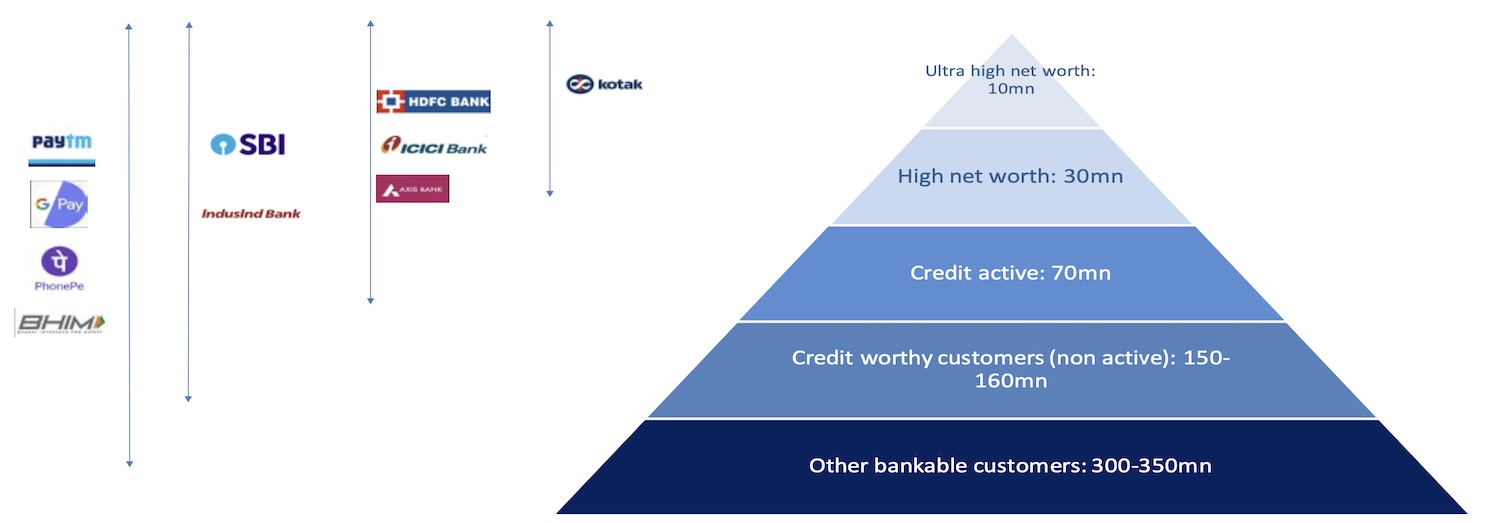
A snapshot of the reach of banks and fintech startups in India. Data: CIBIL, Statista, BofA Global Research. Image: BofA
To be sure, Jupiter, too, will offer loans and other financial services to customers. But instead of making irrelevant calls to customers, it will assess which of its customers are running short on money and give the option to take a credit line from its app itself, he said. “The upsell doesn’t need to happen by way of spam. It needs to happen by way of contextualization and personalization.”
“Jupiter has been built in a deep integration with the underlying bank, allowing the consumer to have a frictionless experience for all their banking needs,” said Amrish Rau, chief executive of Pine Labs, co-founder of CitrusPay and longtime friend of Gupta.
The startup, which employs 115 people, has developed a number of products for customers joining on day one. The products include the ability to buy now and pay later on UPI, a feature first offered in the market by Jupiter, and a mutual fund portfolio analyzer. A debit card, in-app chat with a customer service agent, expense categorisation, finding the right card, determining the existing health insurance coverage, and more are ready to ship, the startup said.
Jupiter is currently working on providing zero mark-up on forex transactions, and frictionless two-factor authentication. The startup has published a public Trello page where it has outlined the features it is working on and when it expects to ship them, as well as features suggested by its beta-testing customers. “I want to establish full transparency in what we are working on to build trust with customers,” said Gupta.
Jupiter will have its own customer relationship team that will engage with the startup’s users. The startup, which last month opened a waiting list for customers to sign up, had amassed more than 25,000 applications as of two weeks ago.
Even Jupiter, which one day wishes to disrupt the banking sector, currently has to partner with banks. Its partners are Federal Bank and Axis Bank.
I asked Gupta about the excitement his investors see in Jupiter. “Everyone believes, as you see with fintech giants such as Nubank globally, that we will become a full bank,” he said.
But for the time being, Gupta said he is not looking to partner with more banks. “I don’t want Jupiter to attract customers because they want to bank with Federal or Axis. I want them to come to Jupiter because they want to bank with Jupiter,” he said.
In the next 12 months, the startup hopes to serve more than 1 million customers.
Powered by WPeMatico
In April, Facebook announced a series of planned investments in new audio products, including a Clubhouse live audio competitor as well as new support for podcasts. Today, Facebook is officially rolling out these products with the launch of Live Audio Rooms in the U.S. on iOS, starting with public figures and select Facebook Groups, and the debut of an initial set of U.S. podcast partners.
The company tells us Live Audio Rooms will become available to any verified public figure or creator in the U.S. who’s in good standing with Facebook and is using either a profile or the new Facebook Pages experience on iOS. For Facebook Groups, the feature is launching with “dozens of groups,” we’re told.
Both products will become more broadly available in the weeks and months ahead, as more people, podcasts and Groups are brought on board. Meanwhile, 100% of Facebook users in the U.S. will be able to listen to Live Audio Rooms and podcasts as of this week.
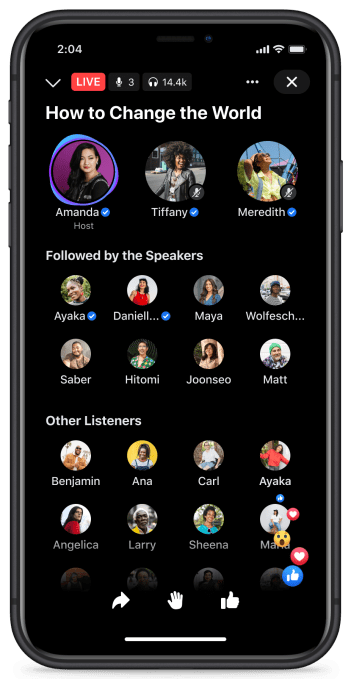
Image Credits: Facebook
Much like Clubhouse or similar audio apps, Facebook’s Live Audio Rooms offer a standard set of features.
The event’s hosts appear in rounded profile icons at the top of the screen, while the listeners appear in the bottom half of the screen, as smaller icons. The active speaker is indicated with a glowing ring. If verified, a check appears next to their name, as well.
There are also options for enabling live captions, a “raise hand” tool to request to speak and tools to share the room with others on Facebook through things like News Feed or Group posts.
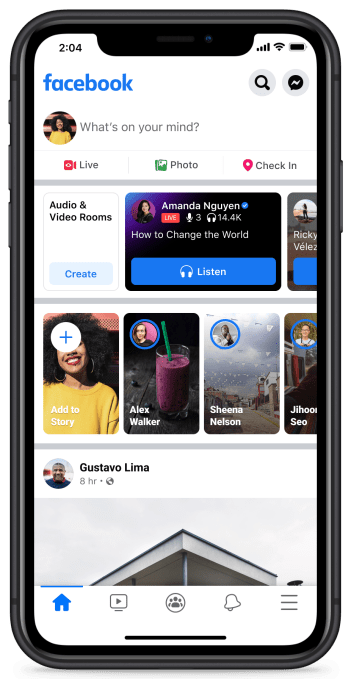
Image Credits: Facebook
Facebook does things a little differently than others in some places. For instance, hosts are able to invite people to join them as a speaker in advance of the session, or they can choose listeners during the stream to join them. In each session, there can be up to 50 speakers and there’s no limit on the number of listeners, Facebook says.
During the session, users will be notified when friends or followers join the chat, too.
While listening, users can “Like” or react to the content as it streams using the “Thumbs Up” button at the bottom of the screen, which connects you to Facebook’s set of emoji reactions. And with today’s official launch, listeners can also now show support to the public figure of the Live Audio Room by sending “Stars.” These Stars can be purchased during the conversation and used at any time, similar to how they work with other Facebook Live content.
By sending Stars, the listener is bumped up to the “Front Row,” a special section that highlights the people who sent the Stars. This allows the event’s hosts to easily recognize their supporters and even give them a shout out during the event, if they choose.
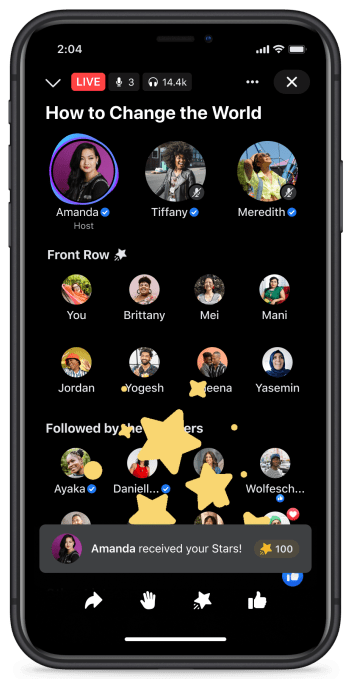
Image Credits: Facebook
Another new feature allows hosts to select a nonprofit or fundraiser to support during their conversation, and listeners and speakers can directly donate. A progress bar will show how much has been raised during the show.
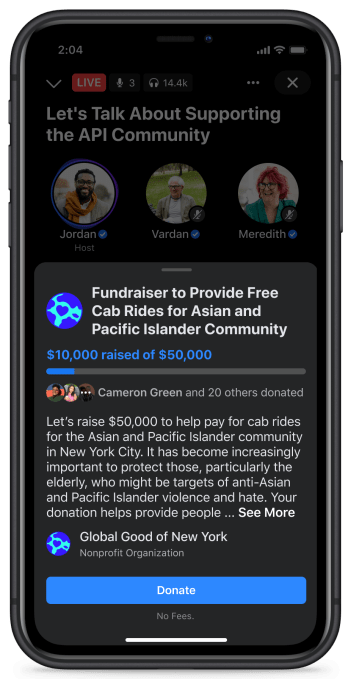
Image Credits: Facebook
Meanwhile, for Facebook Groups, admins can control whether moderators, group members or other admins can create a Live Audio Room. Both members and visitors can listen to the rooms in public groups, but in private groups, the rooms are limited to Group members.
Facebook users are alerted to all the new Live Audio Rooms via the News Feed and Notifications, and can sign up to be reminded when a room they’re interested in goes Live. Live Audio Rooms will also be discoverable within Facebook Groups, where available.
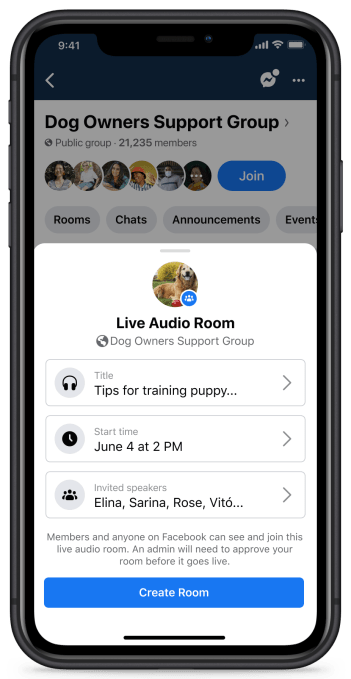
Image Credits: Facebook
Among the initial set of early adopters for Facebook Live Audio Rooms are Grammy-nominated electronic music artist TOKiMONSTA; American football quarterback Russell Wilson; organizer, producer and independent journalist Rosa Clemente; streamer and digital entertainer Omareloff; and social entrepreneur Amanda Nguyen. Others planned for the near future include D Smoke, Kehlani, Reggie Watts and Lisa Morales Duke, as well as Dr. Jess, Bobby Berk, Tina Knowles-Lawson, Joe Budden (notably Spotify’s first big podcast star who it lost last year) and DeRay Mckesson.
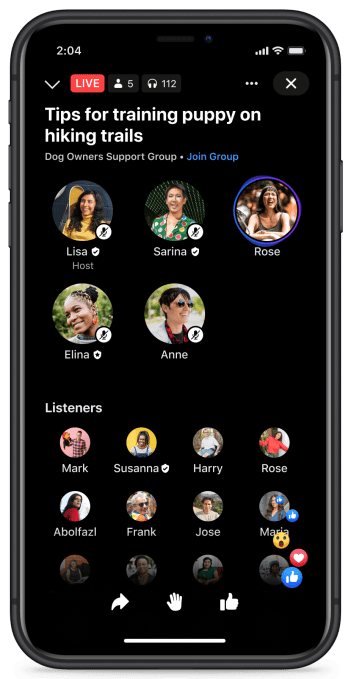
Image Credits: Facebook
Facebook Groups trying the new format include Dance Accepts Everyone, Vegan Soul Food, Meditation Matters, Pow Wow Nation, OctoNation – The Largest Octopus Fan Club! and Space Hipsters.
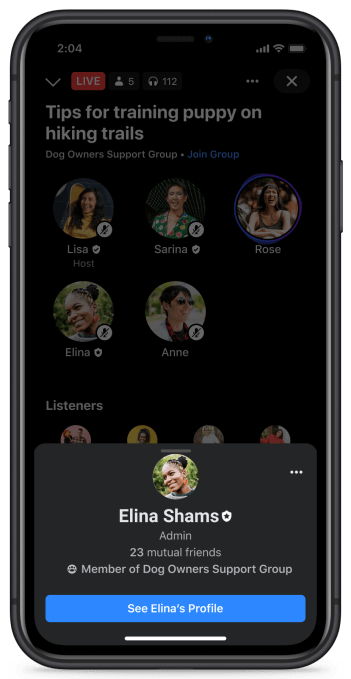
Image Credits: Facebook
Alongside the launch of Live Audio Rooms, Facebook is also beginning to roll out its planned podcast support with a few select creators. These include Joe Budden of The Joe Budden Podcast; “Jess Hilarious” of Carefully Reckless from The Black Effect Podcast Network and iHeartRadio; Keltie Knight, Becca Tobin and Jac Vanek of The LadyGang; and Nicaila Matthews Okome of Side Hustle Pro. Facebook will open up to other podcasters this summer.
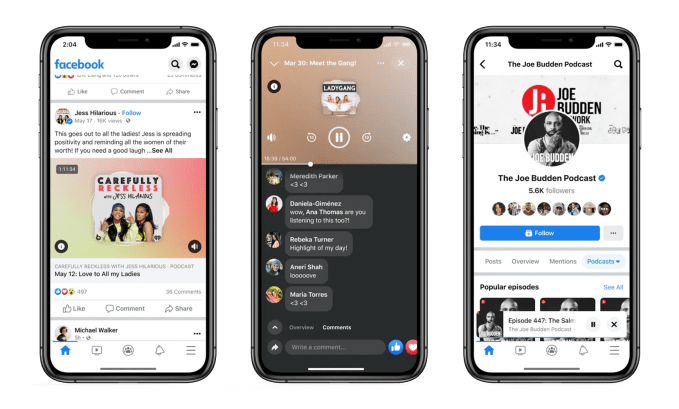
Image Credits: Facebook
To be clear, this new podcasts service is different from the recently launched music and podcasts player in partnership with Spotify, which lets users share content from Spotify to the social network. The new feature instead involves podcasts that are streamed via public RSS feeds directly on Facebook, not delivered by Spotify. However, the miniplayer for podcasts on Facebook will look like the miniplayer for the Spotify listening integration (also known as Project Boombox), and they will behave similarly. But they are not the same.
The new podcast listening experience lets users listen to podcasts as they browse Facebook, either in a miniplayer or full-screen player with playback options, and even if the phone’s display is turned off. This makes Facebook, in a way, a native podcast streaming app because it allows people to listen to audio without needing another service — like Spotify or Apple Podcasts, for example.
Facebook had earlier said there are more than 170 Facebook users who are connected to a Page for a podcast, demonstrating user interest in podcasts on its social network.
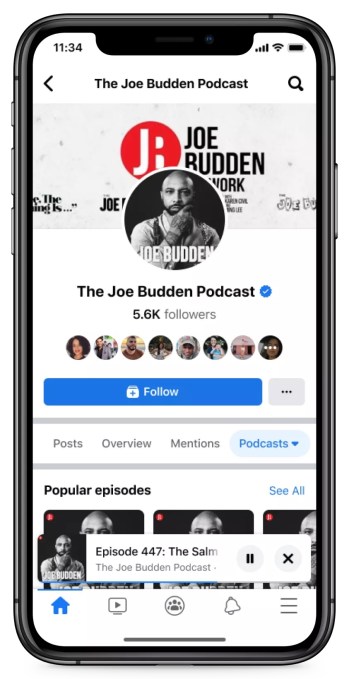
Image Credits: Facebook
With the launch of the Facebook Podcast service, the company is asking podcast creators to give it permission to cache their content on Facebook’s servers, which we’re told is being done to ensure the content doesn’t violate Facebook’s Community Standards. However, because the podcasts are still being streamed via RSS feeds, they will be represented in the metrics provided by a podcaster’s hosting provider.
Last week, Facebook emailed podcast page owners details on how to set up their show on Facebook, noting they can link their podcast’s RSS feed to automatically generate News Feed posts for their episodes. These are also featured on a “podcasts” tab on their Page. According to Facebook’s Podcast Terms of Service, creators are granting Facebook the right to create “derivative works,” which likely refers to an upcoming clips feature.
Facebook says later this summer it will add the ability to create and share short clips from a podcast, along with other features, like captions. Longer-term, it will create social experiences around podcasts, as well. It’s also working with creators to develop and launch its new product, Soundbites, which are short-form, creative audio clips. This will launch later in 2021.
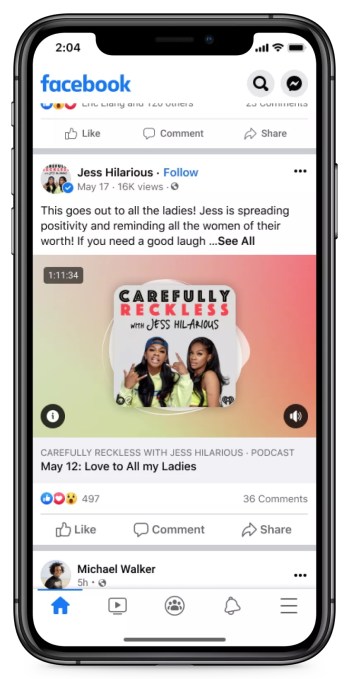
Image Credits: Facebook
Other audio products in the works include a central listening destination and background audio listening for videos.
Facebook says this new destination will be a place where all the different audio formats across Facebook are available, not just podcasts, and will help users find new things and people to listen to. More details on this project will become available later this summer.
Prior to today, Facebook quietly tested Live Audio Rooms in Taiwan and internally with Facebook employees Those tests will continue. Last week, Facebook CEO Mark Zuckerberg hosted the first trial of the new service in the U.S., where he was joined by other Facebook execs and a few Facebook Gaming creators.
Zuckerberg has been bullish on the potential for audio across the social networking platform. He even appeared on Clubhouse a couple of times to discuss the topic ahead of announcing what is, essentially, Facebook’s own Clubhouse competitor.
“I think the areas where I’m most excited about it on Facebook are basically in the large number of communities and groups that exist,” Zuckerberg had told Platformer, at the time of the original announcement. “I think that you already have these communities that are organized around interests, and allowing people to come together and have rooms where they can talk is — I think it’d be a very useful thing,” he added.
Facebook expects to expand its audio products globally in the months ahead.
Powered by WPeMatico